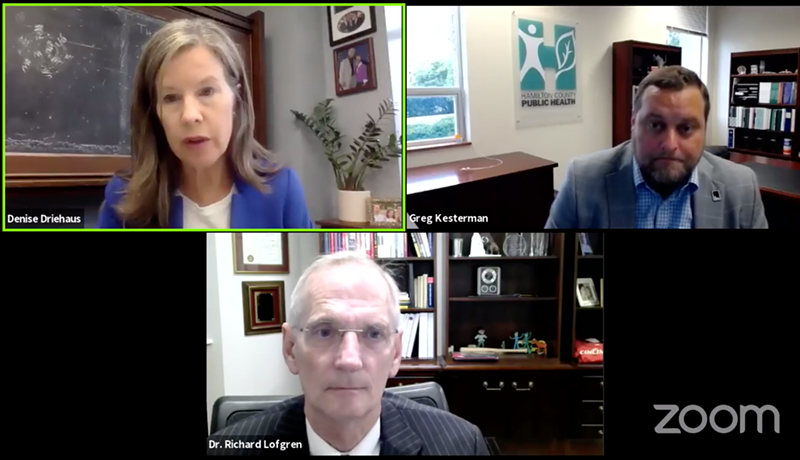
Greater Cincinnati hospitals are feeling the stress from so many COVID-19 patients — especially as more and more healthcare professionals opt for less intense careers.
During a Sept. 22 briefing with Hamilton County Commissioner Denise Driehaus and Hamilton County Public Health Commissioner Greg Kesterman, Dr. Richard Lofgren — UC Health's president and CEO — said that the region's healthcare facilities have been overwhelmed by the current COVID-19 surge. According to the panelists, one in five people using hospital beds and one in three people in intensive care units throughout the region are COVID-19 patients.
"This is above and beyond some of the normal demands on our healthcare system," Lofgren said.
Lofgren said that in Southwestern Ohio, there are typically about 2,400 hospital beds available on a regular basis. In December, about 800 of those were taken by the peak surge of COVID-19 patients, pushing healthcare systems to the brink. Today, Lofgren said, COVID-19 patients are using about 600 beds — a number that at first seems marginally better than last winter's caseload but actually gives way to other problems. Concerns in December largely centered around having enough capacity, medications and supplies to meet the demand.
But now hospitals are worried about the exodus of healthcare staff as coronavirus cases continue to rise and vaccination rates slow to a crawl in Ohio and Kentucky.
"I can tell you that the issue right now for our ability to accommodate this onslaught of demand is really staffing. We really do not have the individuals, the people, that we saw in the winter," Lofgren said.
Healthcare leaders have been sounding the alarm about staffing since shortly after the Delta variant began causing caseload spikes this summer. Dr. Patricia Manning-Courtney, chief of staff at Cincinnati Children's Hospital Medical Center, told Driehaus and Kesterman during a Sept. 1 briefing that the number of children hospitalized with COVID-19 has risen sharply, straining pediatric facilities and contributing to more cases than staff can reasonably take on.
“I really want to stress that our entire pediatric healthcare system is under stress and strain right now. By that, I mean our emergency rooms, our urgent cares, our primary care practices, our community physicians are seeing some of the highest volumes that they ever see,” Manning-Courtney said.
She added that the ever-increasing number of patients means that hospital officials have to make difficult decisions about deferring surgeries, turning away transfer patients and postponing outpatient visits. “That will mean affecting care for everyone — even those who don’t believe that COVID-19 is real."
Lofgren said that many staff members simply have run out of fuel after being on duty essentially since March 2020.
"A number of things factor into it. Quite honestly, there are a number of healthcare providers who have, as a result, really just left the field. I think that a number of people, nurses and other staff, really stepped up and did triple overtime, really extended themselves to accommodate the surge, and as I mentioned before, they're just exhausted," Lofgren said. "And the ability to stretch at that point has really been taxed at a level that, personally, I've never seen before. So I think people need to understand that the health systems right now are overwhelmed and they are strained and really are forced to try to manage the demand."
Lofgren said that staff in area hospitals, including UC Health facilities, have seen an increase in aggressive behavior from patients and families who don't want to wear masks. He also said that though a small percentage healthcare professionals have left employers that are requiring employees to be vaccinated against COVID-19, most simply are exiting the industry.
Driehaus said that patients with COVID-19 or other ailments should carefully consider where they should go for treatment so that strain on the healthcare systems is reduced.
"I want to remind people that when you're thinking about your healthcare, you need to utilize the right level of care so that we don't overload our emergency rooms. So if you've got symptoms and they're worsening, then you think about going to the emergency room. But up to that point, if you've got something that could be handled elsewhere — through an urgent care, through your primary care physician, through an FQHC (federally qualified health center) — then that is the most appropriate route for you to go so that we are not overwhelming our EDs (emergency departments)," Driehaus said.
"Not only is the demand (for care in hospitals) of COVID, but ... we need to continue to take care of critically ill people who have non-COVID conditions," Lofgren said.
Lofgren added a reminder about how to support healthcare staff — by not ending up as a COVID-19 patient in the first place.
"The best thing if you really understand and value the work that the healthcare community (does), besides giving a high five and a distant hug, is to get vaccinated," Lofgren said. "Really, what we can do is to wear a mask, get vaccinated so that we're preventing this disease not only for the welfare of our community but also the ability for us to take care of not only COVID patients but critical non-COVID care, as well."
As of Wednesday, there were 9,000 active cases of COVID-19 and a seven-day average of 363 cases a day in Hamilton County, according to figures from Kesterman. 579 people within the region are hospitalized, 167 are in the ICU and 125 are on ventilators.
For COVID-19 vaccine locations and information, visit coronavirus.ohio.gov in Ohio and kycovid19.ky.gov in Kentucky.
Sign up for our weekly newsletters to get the latest on the news, things to do and places to eat delivered right to your inbox.
Follow us on Facebook, Twitter and Instagram.

